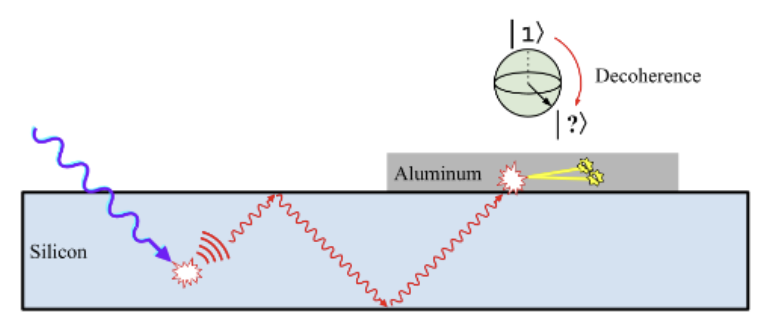Photo Credit: IBM Qubits (Gambetta, J.M. et al)
Quantum Computing (QIS)
Quantum Information Systems (QIS) refers to the use of coupled quantum mechanical systems (qubits) to perform calculations in ways which are either not possible, or prohibitively time consuming for existing “classical” computing systems. The Toback Group at Texas A&M University conducts research in Quantum Information Systems (QIS), focusing on the simulation of the microphysics of devices with superconducting qubits, especially on effects that cause decoherence in superconducting qubits. We are the primary developers and maintainers of the Geant4 Condensed Matter Physics (G4CMP) simulation library, which is used to model charge propagation, phonons and quasiparticles interactions in devices which have semiconductor and superconductor components held at cryogenic temperatures (~millikelvin). This software has applications for both QIS and particle physics applications, such as the Super Cryogenic Dark Matter Search (SuperCDMS) experiment.
Overview
Qubits are typically some form of two-state system (an electron spin up or down, an atom with two energy levels, a superconducting wire with or without current), which can be in either one of the two states, or a superposition of both states at once. If a QIS “device” with multiple qubits can be sufficiently isolated from the environment, those qubits can be entangled, so they have a shared quantum state which evolves in such a way as to perform a desired computation. When the computation finishes, the result can be read out as a measurement of the state of the system.
Our research addresses the challenge of decoherence in quantum computing, where environmental factors, such as radiation, disrupt the stability of qubits. The hypothesis is that energy from external sources enters a device, propagates through the substrate on which the qubit resides, interacts with the superconducting component of the qubit to break Cooper pairs into quasiparticles which can cause a change of state of the qubit. This makes devices vulnerable to energy deposits from sources like cosmic rays or radioactivity. We use simulations to understand and mitigate these effects.
- Model charge and phonon dynamics and phonon-QP interactions in devices.
- Developing chip designs to study controlled phonon bursts and their impact on qubits.
- Expanding G4CMP to support a broader range of qubit types (e.g., transmons, MKIDs) and materials beyond silicon and germanium.
- Improving quantum error correction and sensor designs through simulation.
- Current Members: Toback (PI), Kelsey (Co-PI), Ataee, Lamberson, Lawrence, Monteiro, and Tenpas
- Institutional Partners:
- Current: SLAC, Laurentian University, Fermilab/Northwestern
- Former: MIT, PNNL
For more recent activity see Toback Group News
Radiation Simulation for Quantum Devices (A&M Section)
Talk by Michael Kelsey at SLAC for the ARL SLAC Site Visit
Migrating G4CMP to Geant4 11
Talk by Michael Kelsey at the SuperCDMS Software Working Group Meeting Talk by Michael Kelsey at SUNY Stony Brook (via Zoom) for the Geant4 Users Technical Forum
Re-activating Charge Reflection
Talk by Michael Kelsey at the SuperCDMS DMC sub-WG Meeting and the G4CMP Biweekly Technical Meeting
G4CMP Improvements, Mainly to Superconductors
Talk by Michael Kelsey at the SuperCDMS R&D Working Group
General QIS Documentation:
-
Set of papers related to QIS physics
-
G4CMP Simulation Library: Source Code | Documentation
-
Publications: View our recent papers on arXiv
-
Talk discussing connection between QIS to dark matter searches
